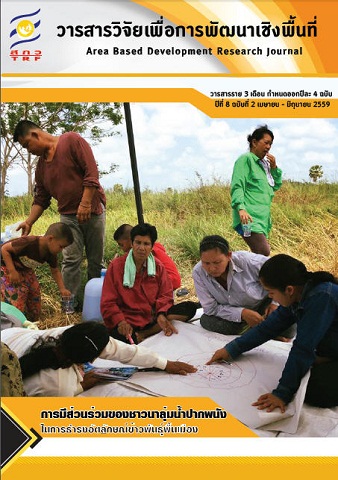การมีส่วนร่วมของชาวนาลุ่มน้ำปากพนังในการธำรงอัตลักษณ์ข้าวพันธุ์พื้นเมือง
Main Article Content
Abstract
บทคัดย่อไม่สมบูรณ์
The Participation of rice farmer at Pakpanang Basin on maimtaining identity of native rice.
Pakpanang Basin areas is the land of plenty and bread basket where has been civilized for more than hundred years. However, nowadays rice farmers who plant native rice lacking of motivation to produce effectively even though they know how to do it well. The reason is that the price of native rice which is produced elegantly is not different from immigrated rice which is planted generally. Therefore, this study will be the important activities in reviving the way of life of local rice farmers and presenting the distinctive identity of native rice. Consequently, native rice farmers will be proud in their native rice and can transmit this cultivation to the next generations in Pakpanang and the public.
This paper demonstrates the farmer’s calendar, the culture of native rice farmers, and the dominant feature of native rice. Later, the researchers will create the presentation in the form of cultural interpretation from the data collection. Participatory Action Research is used in this study. The interviewing and local participation workshop were used to find the identity of native rice and to make the rice farmer’s calendar. Four sub-districts are selected including Pakprek, Thapaya, Kanapnak, and Banperng to be the sample areas of Pakpanong Basin and the key persons who have in-depth knowledge in native rice in 4 sub-districts are selected by snowball method.
It found that the native rice of Pakpanang Basin has been inherited from past until now. In this study, local community made referendum to select the type of native rice as their own dominant native rice of the area. It shown that Luklai native rice belonging to Pakprek sub-district, Yako native rice belonging to Thapaya sub-district, Kabdam native rice belonging to Kanapnak sub-district, and Yumnoon native rice belonging to Banperng sub-district. The native rice in each area has both difference and similarity depending on the factors of geography, and the activities in consumption. The common identity of the four native rice is planting under natural season. They can be planted only one life in a year. They will be grown up by natural resources without chemical fertilizer. They stand to pests. Using participatory action research method resulted that local rice farmers decided to conserve the native rice and its culture in particularly, the ceremony of worship the goddess of rice. Moreover, they committed to pass their native rice culture to the new generations with the reason of sustaining and maintaining their cultural heritage.
Article Details
Area Based Development Research Journal values copyright protection and licensing to safeguard author rights and facilitate the appropriate dissemination of research. Our policies ensure openness, accessibility, and attribution. Authors retain copyright ownership, and articles are published under a Creative Commons Attribution License (CC BY), allowing sharing, adaptation, and proper attribution. Authors have the freedom to publish under the CC BY license, granting broad reuse and distribution permissions. The journal supports posting articles on third-party repositories, adhering to institutional and funding restrictions. Author guidelines detail copyright and licensing requirements, empowering authors with knowledge about their rights and responsibilities. These policies cultivate an environment of collaboration, openness, and responsible sharing, benefiting authors and the research community while honoring intellectual property rights.


